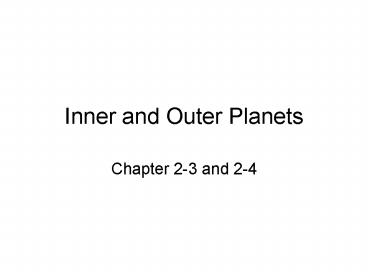Inner and Outer Planets - PowerPoint PPT Presentation
1 / 15
Title:
Inner and Outer Planets
Description:
Closest to the sun. No moons. Hard to view b/c so close to sun ... Other moons Tethys, Lapetus, Dione, and Rhea. Uranus. Much smaller than Jupiter and Saturn ... – PowerPoint PPT presentation
Number of Views:833
Avg rating:3.0/5.0
Title: Inner and Outer Planets
1
Inner and Outer Planets
- Chapter 2-3 and 2-4
2
Inner Planets
- Small and have rocky surfaces
- Four
- Also called terrestrial planets
- Mercury, Venus, Earth, Mars
3
Mercury
- Closest to the sun
- No moons
- Hard to view b/c so close to sun
- Flat plains, many craters (Mariner 10-single
probe) - Atmosphere really thin, weak gravity (b/c so
small), VERY HOT (430C) - Because no atmosphere, heat escapes at night
(-170C)
4
Venus
- In west after sunset (can see it)
- evening star even though its not a star
- Similar in size to earth
- 7.5 earth months to revolve around the sun
- 8 months to rotate (so year is less than day)
- Retrograde rotation rotates from east to west
5
Venus Cont
- Atmosphere very thick, every day is cloudyno
sunny days - If you stood on Venus, you would be crushed by
the atmosphere - Becomes hotter and hotter because carbon dioxide
traps heat Greenhouse Effect - Magellan had radar that could go through
atmosphere
6
Earth
- Atmosphere of mostly oxygen
- 70 covered with water (like no other planet)
- 3 main layers crust, mantle, core
7
Mars
- red planet
- Atmosphere is mostly carbon dioxide
- Has some water present in the form of ice
- Has seasons axis is tilted, wind causes dust
storms - Lost of spacecrafts have been there!
- 2 very small moons
8
The Outer Planets
- Jupiter
- Saturn
- Uranus
- Neptune
- Pluto?????
9
Gas Giants
- First 4 outer planets Jupiter, Saturn, Uranus,
Neptune - Gas Giant very large
- Pluto (not included) small and rocky like
terrestrial planets
10
Jupiter
- Largest Planet
- Atmosphere thick atmosphere made up mainly of
hydrogen and helium - Contains colorful bands and swirls of thick
clouds (Great Red Spot similar to an ongoing
hurricane on earth, never ending storm) - Moons Io, Europa, Ganymede, and Callisto
11
Jupiters Moons
- Io covered with volcanoes, erupting all the
time, so Ios surface changes (larger than
Earths own moon) - Ganymede largest of Jupiters moons, twice the
mass of earths moon.surface is icy and partly
covered with craters (partly giant grooves of
ice) - Callisto icy surface, covered with craters
12
Saturn
- Second-largest planet
- Thick atmosphere
- Clouds and storms
- Planet is less dense than water
- Rings made of chunks of ice and rock, traveling
around its own orbit around Saturn - Hundreds of rings
- Titan largest moon (very thick atmosphere)
- Other moons Tethys, Lapetus, Dione, and Rhea
13
Uranus
- Much smaller than Jupiter and Saturn
- Much colder (twice as far from sun as Saturn)
- 17 hours to rotate (day)
- 90 degree tilt on axis, so rotates from top to
bottom instead of side to side - Moons 5 large moons (icy surfaces)
- Cratered surfaces
- Lava flows
14
Neptune
- Atmosphere has visible clouds
- Great Dark Spot giant storm
- 5 years later, dark spot was gone
- Smaller spots seem to come and go
- Moons 8 moons revolving around Neptune
- Largest moon Triton (cap of ice on southern
pole.dark material erupts from underneath)
15
Pluto and Charon
- Solid surfaces
- Much less mass than earth
- Double planet instead of planet and moon
- 248 earth years is one year on Pluto (because so
far away from sun) - So small, is it a planet?????































